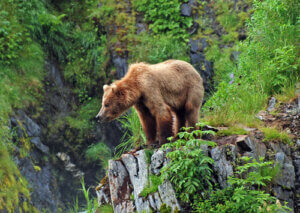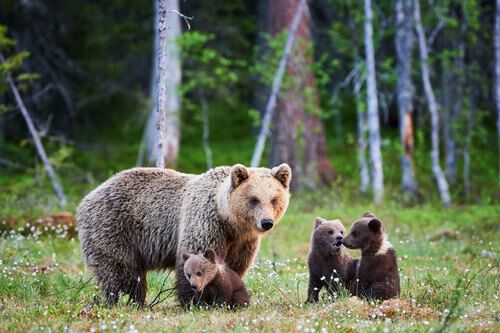The Grizzly Bear: The Most Famous Forest Animal

Yogi bear (the Hannah-Barbera animated character) or, perhaps, Yellowstone National Park may come to mind when you think of a grizzly bear. However, this enormous animal, one of the largest of the family, is more than that. Learn all about it in the following article.
Characteristics and distribution of the grizzly bear
The scientific name for this animal is Ursus horribilis and it’s one of the subspecies of this type of bear. It inhabits the highlands of North America and Siberia. Indeed, it’s quite popular in the national parks of the USA, although the largest population of grizzly bears is in Alaska.
This species is the third-largest in North America — the polar and the Kodiak bear are larger. This animal can weigh over 1300 pounds and is almost 4 feet high on all fours. Also, it can reach over 8 feet when standing on its hind legs.
The grizzly bear differs from the black bear in that it has a “hump” on its back. This is nothing more than the muscle mass from digging dens with their front legs. Likewise, its hind legs are more powerful and agile; they can run at a speed of 35 miles per hour.
The claws of a grizzly bear are larger than those of the rest of their family. Another inherent characteristic is they have an area of silver-tipped fur on their back — the rest is brown. This is precisely what inspired their well-known name. This is because grizzly comes from “grizzled.”

Habits and diet
Grizzly bears are carnivores, as evidenced by their digestive system. However, evolution and specific needs forced them into acquiring a taste for plant-based food. In fact, these comprise about 90% of their diet at certain times of the year. They eat anything from fruit, grasses, bark, pine cones, nuts, tubers, and roots. In addition, they also snack on bugs and worms.
Then, when summer arrives, they add large prey such as deer, caribou, reindeer, and wapiti to their menu. They may also catch a bison or a black bear calf. Furthermore, those who inhabit coastal areas are quite good at catching salmon, trout, and bass. Their technique consists of positioning themselves near a waterfall and waiting for the fish to jump in order to catch them with their powerful teeth.
Grizzly bears hibernate and begin to overeat a few weeks before entering their den — when a big snowstorm breaks out. It helps them gain about 400 pounds in a matter of days.
Mating season
Males tend to be quite aggressive when they’re looking for a female to mate and fight with other opponents. This is the only time they come together, as bears are solitary for the most part. They may even kill cubs so that they don’t challenge them in the future.
The mating season takes place between May and July. In addition, courtship is simple and males take off in search of other one-night girlfriends after copulation.
In turn, the females take over the rearing of the young after 270 days of gestation (they have a maximum of two per litter). Then, the young spend several years learning how to get their own food by watching their mother. They move away from her when they’re sexually mature — at between two and four years of age.

The predators of the grizzly bear
Let’s get real, grizzly bears have no predators other than themselves in the wild — either for reproductive reasons or due to food shortages. Also, this species isn’t endangered as it inhabits protected areas. You probably already guessed that humans are the main threat to these humongous creatures.
This animal is considered aggressive due to its large size and fierceness but attacks on people aren’t common. Indeed bears have a physical advantage over humans but they don’t prey on us.
Most fatal attacks by grizzly bears involve a mother and cubs. This is because mothers are overly protective at this stage and won’t hesitate to use their strength against any threat, be it real or imaginary.
Many grizzly bears have become used to the presence of humans and the latter can come near and watch them safely in preserved natural areas.
Yogi bear (the Hannah-Barbera animated character) or, perhaps, Yellowstone National Park may come to mind when you think of a grizzly bear. However, this enormous animal, one of the largest of the family, is more than that. Learn all about it in the following article.
Characteristics and distribution of the grizzly bear
The scientific name for this animal is Ursus horribilis and it’s one of the subspecies of this type of bear. It inhabits the highlands of North America and Siberia. Indeed, it’s quite popular in the national parks of the USA, although the largest population of grizzly bears is in Alaska.
This species is the third-largest in North America — the polar and the Kodiak bear are larger. This animal can weigh over 1300 pounds and is almost 4 feet high on all fours. Also, it can reach over 8 feet when standing on its hind legs.
The grizzly bear differs from the black bear in that it has a “hump” on its back. This is nothing more than the muscle mass from digging dens with their front legs. Likewise, its hind legs are more powerful and agile; they can run at a speed of 35 miles per hour.
The claws of a grizzly bear are larger than those of the rest of their family. Another inherent characteristic is they have an area of silver-tipped fur on their back — the rest is brown. This is precisely what inspired their well-known name. This is because grizzly comes from “grizzled.”

Habits and diet
Grizzly bears are carnivores, as evidenced by their digestive system. However, evolution and specific needs forced them into acquiring a taste for plant-based food. In fact, these comprise about 90% of their diet at certain times of the year. They eat anything from fruit, grasses, bark, pine cones, nuts, tubers, and roots. In addition, they also snack on bugs and worms.
Then, when summer arrives, they add large prey such as deer, caribou, reindeer, and wapiti to their menu. They may also catch a bison or a black bear calf. Furthermore, those who inhabit coastal areas are quite good at catching salmon, trout, and bass. Their technique consists of positioning themselves near a waterfall and waiting for the fish to jump in order to catch them with their powerful teeth.
Grizzly bears hibernate and begin to overeat a few weeks before entering their den — when a big snowstorm breaks out. It helps them gain about 400 pounds in a matter of days.
Mating season
Males tend to be quite aggressive when they’re looking for a female to mate and fight with other opponents. This is the only time they come together, as bears are solitary for the most part. They may even kill cubs so that they don’t challenge them in the future.
The mating season takes place between May and July. In addition, courtship is simple and males take off in search of other one-night girlfriends after copulation.
In turn, the females take over the rearing of the young after 270 days of gestation (they have a maximum of two per litter). Then, the young spend several years learning how to get their own food by watching their mother. They move away from her when they’re sexually mature — at between two and four years of age.

The predators of the grizzly bear
Let’s get real, grizzly bears have no predators other than themselves in the wild — either for reproductive reasons or due to food shortages. Also, this species isn’t endangered as it inhabits protected areas. You probably already guessed that humans are the main threat to these humongous creatures.
This animal is considered aggressive due to its large size and fierceness but attacks on people aren’t common. Indeed bears have a physical advantage over humans but they don’t prey on us.
Most fatal attacks by grizzly bears involve a mother and cubs. This is because mothers are overly protective at this stage and won’t hesitate to use their strength against any threat, be it real or imaginary.
Many grizzly bears have become used to the presence of humans and the latter can come near and watch them safely in preserved natural areas.
This text is provided for informational purposes only and does not replace consultation with a professional. If in doubt, consult your specialist.








